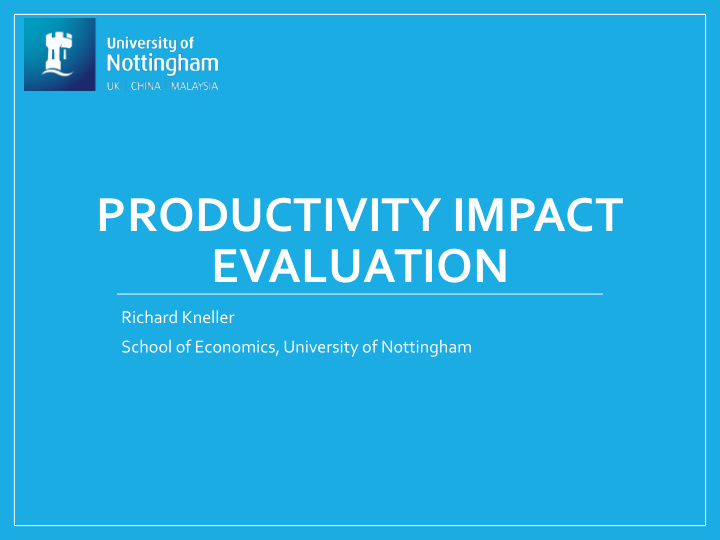



PRODUCTIVITY IMPACT EVALUATION Richard Kneller School of Economics, University of Nottingham
The productivity of those firms given ‘productivity support’ depends on the support itself and other factors (confounding variables) Productivity Confounding Improvement Productivity Variable Programme To remove the effect of the confounding variables requires a comparison to a counterfactual. Couterfactual Effect of the PIP Group group PIP
Basic Problem of Impact Evaluation Mis-measured Impact when using before/after comparisons during Global Financial Crisis years productivity Impact ≠ B - A A B Productivity of supported firms “Counterfactual” no support provided C Impact = B - C An increase in productivity 2006 2007 2008 2009 Years Treatment Period
Are confounding factors a problem? • The average multinational is more productive than a small domestically owned firms that sells just to the local market • But, some multinational firms are only as productive as these small domestic-focused firms • And, some small domestic-focused firms are as productive as multinationals! • The most productive cardboard box producers generate 3 times more output from the same cardboard, employees and machines as the least productive ones.
What determines productivity? R&D Capital Competition Investment Productivity Infrastructure Skills International Management Trade/FDI Suppliers
Impact Evaluation Methods • We don’t fully know what the confounding • Case studies productivity factors are, nor why they are • Simple correlation regressions Weakest important • The counterfactual cannot be observed so it must be created using data on other firms. • Matching • Confounding variables come in different types • Different methods remove different types of • Difference-in-differences confounding variables (so they may leave some behind!) • For those methods we have to assume that • Regression discontinuity • Instrumental variable confounding variables of those particular types are not present • The most successful way to do this is • Randomised control trial randomisation Strongest • RCT’s do this before firms get support, other methods try to re-create it afterwards
Common types of RCT • Oversubscription – if there are not the resources to provide support to all firms, then a fair way of choosing who to support would be to randomise this choice. • Phase-in – as there are likely to be constraints on the number of firms that can be supported at any one time, the support might be phased in. Which phase firms are supported in could be decided randomly. • Encouragement design – an encouragement to receive the treatment is randomly assigned. Participation is available to anyone who applies but some, randomly chosen, are encouraged to apply.
How can D2N2 raise productivity? UK wide D2N2 specific • Creation of new technologies • Target the middle firms • Increase investment in new • Management Practice and capital Organisation • Evidence of an export gap • Efficient use of new • Evidence of a technologies ‘management’ gap • Access to finance • Support for small productive • Entry of better firms and firms – not just small firms weaker firms to exit • Skills - limited direct effect, • Infrastructure & market but pays off as a access complement to better technologies
Recommend
More recommend